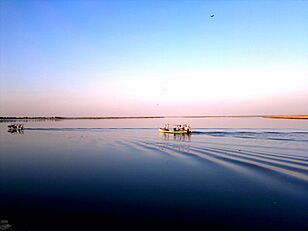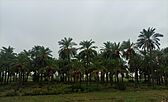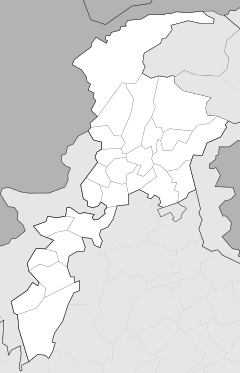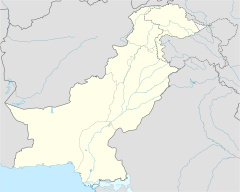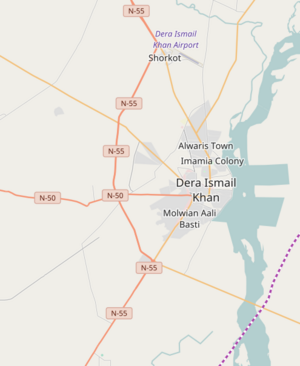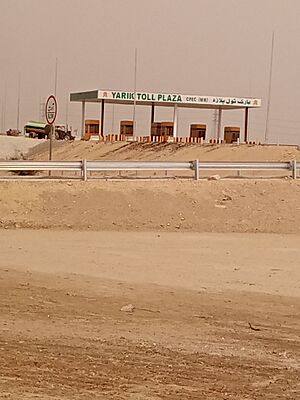Dera Ismail Khan facts for kids
Quick facts for kids
Dera Ismail Khan
ڈیره اسماعیل خان
دېره اسماعيل خان |
|
|---|---|
|
City
|
|
|
Clockwise from top: Indus River, Lal Mahra Tombs, Qureshi Morr, Kalma at Kachehri Chowk, Noll Bagh, Kalma Chowk, Kafir Kot ruins, State Life Building
|
|
| Country | |
| Province | |
| District | Dera Ismail Khan |
| Tehsil | Dera Ismail Khan |
| Government | |
| • Type | Mayor-council |
| Elevation | 165 m (541 ft) |
| Population
(2017)
|
|
| • City | 217,457 |
| • Rank | 37th, Pakistan; 5th, Khyber Pakhtunkhwa |
| Dera Ismail Khan Municipal Committee: 211,760 Dera Ismail Khan Cantonment: 5,697 |
|
| Time zone | UTC+5 (PKT) |
| Postal code |
29050
|
| Number of union councils | 47 |
Dera Ismail Khan (/deɪrʌ-ɪsmaɪ.iːl-xɑːn/; Urdu and Saraiki: ڈیرہ اسماعیل خان, Pashto: ډېره اسماعيل خان), abbreviated as D.I. Khan, is a city and capital of Dera Ismail Khan District, located in Khyber Pakhtunkhwa, Pakistan. It is the 37th largest city of Pakistan and fifth largest in the province of Khyber Pakhtunkhwa by population. Dera Ismail Khan is situated on the west bank of the Indus River, at its junction with the Gomal River.
It is 300 kilometres (190 mi) south of the provincial capital Peshawar, and 230 kilometres (140 mi) northwest of Multan, Punjab.
Contents
Etymology
In the local language, the word ḍerā means "tent, encampment", and is commonly found in the name of towns in the Indus Valley such as Dera Ghazi Khan and Dera Bugti. It is named after Dodai mercenary Ismail Khan, son of Malik Sohrab Dodai, who founded the town. "Dera Ismail Khan" thus means "Camp of Ismail Khan."
History
Foundation
Early history
The region around Dera Ismail Khan has been inhabited for millennia, as evidenced by the nearby site of Rehman Dheri — a pre-Harappan archaeological site dating back from 3300 BCE. In the seventh century, the city had a large population of Brahmins and Buddhists.
Medieval history
D. I. Khan is located in the historical Derajat region, which was established in the 15th century, when Baloch people were invited to settle the region by Shah Husayn, of the Langah Sultanate of Multan.
Baloch settlers were assimilated through the, later waves of Pashtun settlement, although villagers along the alluvial plains are typically Baloch or Jat.
Dera Ismail Khan region was part of Multan Subah of Mughal Empire, though D. I Khan never attained a station of great power or importance before the British period. D. I. Khan grew prosperous as a trading centre for Powindah nomads, during Nader Shah's invasion of the Mughal Empire.
D. I. Khan was ruled by nine generations of Baloch leaders descended directly from Ismail Khan. The last, Nusrat Khan, was removed from power after the city was captured by Ahmad Shah Durrani in 1750. In 1794, the city was granted to Nawab Muhammad Khan Sadozai by Shahzada Kamran Durrani.
Re establishment of the city
The original town was swept away by flooding on the Indus River in 1823. The present city was founded by Nawab Sher Muhammad Khan of the Saddozai clan in 1825, and now stands four miles (6 km) away from the permanent channel of the river, atop a small plateau. Nawab Sadozai took into consideration the opinions of Diwan Lakhi Mal and Tej Bhan Nandwani for the city's reconstruction. Architects were brought in from Punjab, who designed a city where Hindus would live south of the city center and Muslims north of it.
Four bazaars were laid in each of the cardinal directions, with all four converging in the town's central Chowgalla. The rebuilt city contained a large bazaar for Afghan traders, and the city prospered from trade via the Gomal Pass. An eight foot mud wall with nine gates was built around the city during this time as well, some of which such as the Kaneran Wala and Sakki survive until today. All existing buildings date from no earlier than the 19th century.
Sikh rule (1821–1849)
D. I. Khan remained under Sadozai rule from the nearby town of Mankera until it was annexed by Bhatti Jatsikh ruler Maharaja Nau Nihal Singh of the Sikh Empire in 1836. Diwan Lakhi Mal appointed city's Kardar ruler, though the Nawabs of the city from the Durrani order were allowed to maintain their title and some income. The city suffered under punitive taxes that lead to frequent complaints in the Sikh Darbar at Lahore, resulting in several changes of Kardar.
Colonial British India era
D. I. Khan's first deputy commissioner under British Indian Empire was General Henry Charles Van Cortland, who arrived in February 1848, before departing later that year to quell a revolt in nearby Multan. Following the defeat of rebels at Multan, Lieutenant Butler was made the next deputy commissioner of D. I. Khan and Bannu. Under his rule, city's infrastructure and colonial administration system were established in which top posts were exclusively occupied by the British. The city was on the edge of the Tribal Areas — lands that were frequently in rebellion against British Indian Empire. The town did not rise up in revolt against British Indian Empire during the 1857 Sepoy Mutiny. In 1861, D. I. Khan was made into the Divisional Capital of the new Dera Ismail Khan Division: analogous to a British county.
The municipality was constituted in 1867, while the Dera Ismail Khan Cantonment was established in 1894. By 1881 the city's population was 22,164. The military cantonment area, which lies southeast of the town, had an area of 44 square miles (110 km2), excluding the portion known as Fort Akalgarh on the northwest side.
The Dera Ismail Brigade had its winter headquarters at Dera Ismail Khan, and the garrison consisted of a mountain battery, a regiment of Native cavalry, and three regiments of Native infantry. Detachments from these regiments helped to garrison the outposts of Drazinda, Jandola, and Jatta. The "Civil Lines" neighborhood was built to the south.
The town possessed a civil hospital; its chief educational institutions were two aided Anglo-vernacular high schools, one maintained by the Church Missionary Society and the other by the Bharatri Sabha, and an Anglo-vernacular middle school maintained by the municipality.
According to the 1901 census, the population of Dera Ismail Khan was 31,737, of whom 18,662 were Muslims, 11,486 Hindus, and 1,420 Sikhs. Of the total, 3,450 lived in the cantonment. I
The predominantly Muslim population (which accounted for more than 80 % of the local population of Dera Ismail Khan) supported the Muslim League and the Pakistan Movement. After the Partition of India and independence of Pakistan in 1947, the minority Hindus and Sikhs migrated to India, while the Muslim migrants from India settled in Dera Ismail Khan. In India, Model Town, Vijay Nagar and Derawal Nagar colony in Delhi absorbed many Hindu former residents of D. I. Khan.
After Independence of 1947
Following an influx of refugees following the 1979 Soviet invasion of Afghanistan, D. I. Khan's population tripled.
As part of the 2015 China-Pakistan Economic Corridor, it was announced that D. I. Khan would be the terminus of the Hakla–Dera Ismail Khan Motorway — a four-lane controlled access motorway, 280 km in length, that is to begin at the M1 near Islamabad and serve as part of the Western Alignment of the economic corridor.
Geography
Climate
Dera Ismail Khan has a hot desert climate (Köppen BWh), bordering on a hot steppe climate (Koppen: BSh), with sweltering summers and warm winters. Rain mainly falls in two distinct periods: in the late winter and early spring from February to April, and in the monsoon in July and September.
D. I Khan is situated at an altitude of 177 metres above sea level.
| Climate data for Dera Ismail Khan | |||||||||||||
|---|---|---|---|---|---|---|---|---|---|---|---|---|---|
| Month | Jan | Feb | Mar | Apr | May | Jun | Jul | Aug | Sep | Oct | Nov | Dec | Year |
| Record high °C (°F) | 28.9 (84.0) |
30.6 (87.1) |
37.2 (99.0) |
43.3 (109.9) |
47.9 (118.2) |
51 (124) |
47.0 (116.6) |
44.5 (112.1) |
42.4 (108.3) |
40.5 (104.9) |
35.0 (95.0) |
30.6 (87.1) |
51 (124) |
| Mean daily maximum °C (°F) | 20.3 (68.5) |
22.1 (71.8) |
26.9 (80.4) |
33.5 (92.3) |
38.7 (101.7) |
41.5 (106.7) |
38.5 (101.3) |
37.4 (99.3) |
36.7 (98.1) |
33.4 (92.1) |
27.7 (81.9) |
21.9 (71.4) |
31.5 (88.8) |
| Daily mean °C (°F) | 12.2 (54.0) |
14.7 (58.5) |
19.9 (67.8) |
26.0 (78.8) |
30.9 (87.6) |
34.2 (93.6) |
32.7 (90.9) |
31.9 (89.4) |
30.2 (86.4) |
25.3 (77.5) |
19.1 (66.4) |
13.6 (56.5) |
24.2 (75.6) |
| Mean daily minimum °C (°F) | 4.2 (39.6) |
7.3 (45.1) |
12.9 (55.2) |
18.5 (65.3) |
23.1 (73.6) |
26.8 (80.2) |
26.9 (80.4) |
26.4 (79.5) |
23.8 (74.8) |
17.3 (63.1) |
10.5 (50.9) |
5.3 (41.5) |
16.9 (62.4) |
| Record low °C (°F) | −2.2 (28.0) |
−2.0 (28.4) |
4.0 (39.2) |
9.5 (49.1) |
14.4 (57.9) |
17.5 (63.5) |
18.6 (65.5) |
19.5 (67.1) |
15.8 (60.4) |
8.0 (46.4) |
2.2 (36.0) |
−2.8 (27.0) |
−2.8 (27.0) |
| Average rainfall mm (inches) | 10.0 (0.39) |
17.5 (0.69) |
34.8 (1.37) |
21.7 (0.85) |
17.2 (0.68) |
24.4 (0.96) |
69.8 (2.75) |
67.5 (2.66) |
37.6 (1.48) |
4.8 (0.19) |
2.1 (0.08) |
10.4 (0.41) |
317.8 (12.51) |
| Mean monthly sunshine hours | 222.2 | 206.8 | 234.3 | 259.2 | 290.1 | 247.7 | 241.3 | 261.1 | 271.1 | 283.2 | 249.7 | 220.4 | 2,987.1 |
| Source: NOAA (1961-1990) | |||||||||||||
| Climate data for Dera Ismail Khan (1991–2020) | |||||||||||||
|---|---|---|---|---|---|---|---|---|---|---|---|---|---|
| Month | Jan | Feb | Mar | Apr | May | Jun | Jul | Aug | Sep | Oct | Nov | Dec | Year |
| Mean daily maximum °C (°F) | 19.5 (67.1) |
22.6 (72.7) |
27.3 (81.1) |
34.0 (93.2) |
39.6 (103.3) |
41.0 (105.8) |
38.5 (101.3) |
37.5 (99.5) |
36.5 (97.7) |
33.5 (92.3) |
27.7 (81.9) |
22.4 (72.3) |
31.7 (89.1) |
| Daily mean °C (°F) | 12.1 (53.8) |
15.3 (59.5) |
20.3 (68.5) |
26.4 (79.5) |
31.6 (88.9) |
33.4 (92.1) |
32.5 (90.5) |
31.8 (89.2) |
30.1 (86.2) |
25.7 (78.3) |
19.4 (66.9) |
14.2 (57.6) |
24.4 (75.9) |
| Mean daily minimum °C (°F) | 4.6 (40.3) |
8.0 (46.4) |
13.4 (56.1) |
18.9 (66.0) |
23.7 (74.7) |
25.9 (78.6) |
26.5 (79.7) |
26.0 (78.8) |
23.8 (74.8) |
17.9 (64.2) |
11.1 (52.0) |
5.8 (42.4) |
17.1 (62.8) |
| Average precipitation mm (inches) | 12.6 (0.50) |
24.0 (0.94) |
37.4 (1.47) |
29.1 (1.15) |
9.1 (0.36) |
38.3 (1.51) |
71.5 (2.81) |
72.4 (2.85) |
37.8 (1.49) |
19.6 (0.77) |
3.4 (0.13) |
4.4 (0.17) |
369.6 (14.55) |
| Average precipitation days (≥ 1.0 mm) | 2.1 | 3.5 | 5.0 | 3.8 | 1.8 | 2.6 | 4.1 | 3.8 | 1.9 | 1.0 | 0.7 | 0.9 | 31.2 |
| Mean monthly sunshine hours | 193.4 | 196.5 | 229.3 | 265.8 | 279.1 | 265.5 | 247.7 | 260.5 | 262.7 | 263.4 | 215.5 | 218.3 | 2,897.7 |
| Source: NOAA | |||||||||||||
Demographics
| Religious group |
1881 | 1901 | 1911 | 1921 | 1931 | 1941 | 2017 | |||||||
|---|---|---|---|---|---|---|---|---|---|---|---|---|---|---|
| Pop. | % | Pop. | % | Pop. | % | Pop. | % | Pop. | % | Pop. | % | Pop. | % | |
| Islam |
12,440 | 56.13% | 18,662 | 58.8% | 21,759 | 61.94% | 21,056 | 53.52% | 22,321 | 55.34% | 26,424 | 51.5% | 215,348 | 98.78% |
| Hinduism |
8,862 | 39.98% | 11,486 | 36.19% | 11,716 | 33.35% | 17,077 | 43.41% | 16,761 | 41.56% | 22,815 | 44.47% | 438 | 0.2% |
| Sikhism |
680 | 3.07% | 1,420 | 4.47% | 1,331 | 3.79% | 724 | 1.84% | 708 | 1.76% | 1,412 | 2.75% | N/A | N/A |
| Jainism |
2 | 0.01% | 15 | 0.05% | 0 | 0% | 0 | 0% | 0 | 0% | N/A | N/A | N/A | N/A |
| Christianity |
N/A | N/A | 154 | 0.49% | 325 | 0.93% | 484 | 1.23% | 541 | 1.34% | 195 | 0.38% | 2,166 | 0.99% |
| Judaism |
N/A | N/A | 0 | 0% | 0 | 0% | 0 | 0% | 0 | 0% | 1 | 0% | N/A | N/A |
| Zoroastrianism |
N/A | N/A | 0 | 0% | 0 | 0% | 0 | 0% | 0 | 0% | 0 | 0% | N/A | N/A |
| Buddhism |
N/A | N/A | 0 | 0% | 0 | 0% | 0 | 0% | 0 | 0% | N/A | N/A | N/A | N/A |
| Ahmadiyya |
N/A | N/A | N/A | N/A | N/A | N/A | N/A | N/A | N/A | N/A | N/A | N/A | 32 | 0.01% |
| Others | 180 | 0.81% | 0 | 0% | 0 | 0% | 0 | 0% | 0 | 0% | 459 | 0.89% | 34 | 0.02% |
| Total population | 22,164 | 100% | 31,737 | 100% | 35,131 | 100% | 39,341 | 100% | 40,331 | 100% | 51,306 | 100% | 218,018 | 100% |
Transportation
Road
.
The city is connected to Bannu via the highway, which further connects it to the provincial capital of Peshawar via Kohat and Darra Adam Khel. Another road connects D. I. Khan to Mianwali through Chashma Barrage, and another connects the city to Zhob. The third major road connects it to Bhakkar in Punjab, situated on the eastern bank of the Indus River. A bridge on the Indus River was constructed in the early 1980s, before which the approach to Bhakkar was made through a boat bridge. Another road connect it to district Tank which further leads towards Jandola-AngoorAdda areas of South South Waziristan district at North west and Pezu on eastern side.
D. I. Khan is at the terminus of the Hakla–Dera Ismail Khan Motorway — a 280-km, four-lane controlled access motorway that is to extend from the Hakla Interchange on the M1 Motorway, near Islamabad to D. I. Khan.
Air
The city is served by Dera Ismail Khan Airport, though no commercial flights operate to the airport.
See also
 In Spanish: Dera Ismail Khan para niños
In Spanish: Dera Ismail Khan para niños


